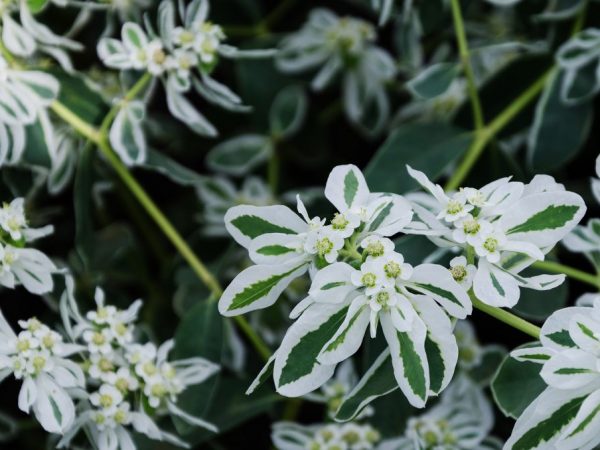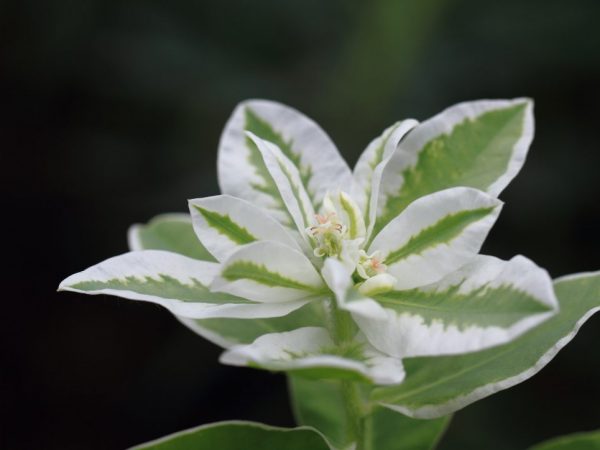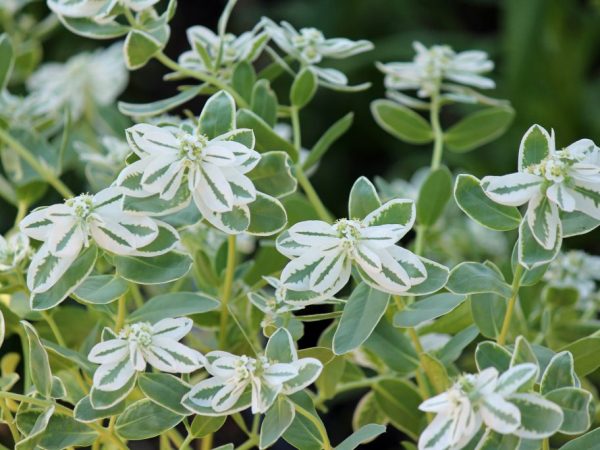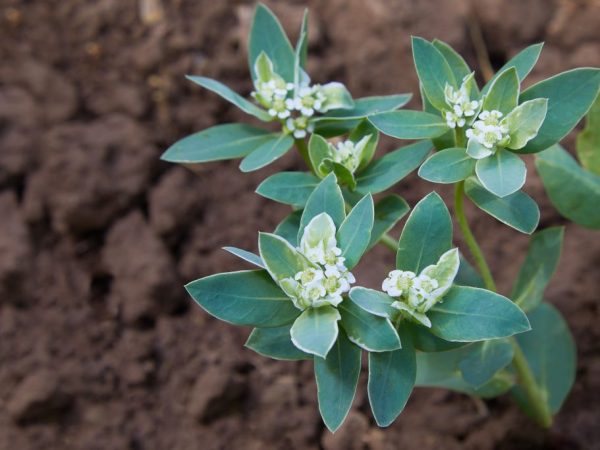Euphorbia Bordered - the best tips for growing
One of the brightest and most popular garden plants is bordered euphorbia. This culture is native to the highlands of North America, belongs to ornamental herbaceous shrubs, attracts attention with variegated foliage. Consider what a bush looks like, what kind of care it needs and growing conditions.

Euphorbia Bordered - the best tips for growing
general characteristics
The botanical name is Euphorbia marginata. Belongs to the Euphorbia family. The people call the bush - Mountain or Early Snow.
A herbaceous bush with numerous branches, densely covered with variegated foliage - outwardly it resembles lace and is a bright decoration of the site.
The plant is characterized by intensive growth - during the season, the stems can reach 80-90 cm in length, the crown circumference is 70-75 cm.
Description:
- depending on the season, the shade of the leaves changes: in spring it is light gray, in summer during flowering it is snow-white;
- small white flowers bloom at the top of the stems, which give the bush an additional decorative effect;
- long flowering - begins in mid-summer and ends in early autumn;
- after the inflorescences dry out, seed pods are formed, later they crack and the seeds fly in different directions;
- in its natural environment reproduces by self-seeding.
This species is an annual, although some consider it to be a perennial. White-bordered spurge has a weak frost resistance, therefore it freezes over the winter even with the slightest frost.
Benefit and harm
Euphorbia has unique beneficial properties - relieves inflammation, relieves pain, expels all parasites from the body, an infusion based on leaves and stems helps to get rid of gastrointestinal diseases, fungus and eczema.
In addition to the benefits, the plant can be harmful - if it breaks, poisonous milky juice is released. In contact with skin and mucous membranes, it causes allergies. Therefore, when caring for him, it is necessary to wear rubber gloves and a protective mask with goggles.
Varieties
Mountain snow
The second name is rock crystal, or snowy peaks.
Shrub annual 70-80 cm high with good branching. The leaves are small in size - up to 5 cm long, grayish-green in spring, become variegated in summer during the flowering period - there is a white border around the edge. The shape of the leaves is oval or round with a pointed tip.
Inflorescences bloom at the tops of the shoots. The culture is prized for its lush and abundant flowering. Seed ripening occurs in early or mid-September. Euphorbia reproduces successfully by self-seeding.
Rich bride
The variety is large in size and takes up a lot of space in the flower garden. Shrub height - 1 m, width 90-95 cm.
Throughout the growing season, it can change the color of the leaves: in spring - green leaves with a grayish tint. In summer, when small snow-white inflorescences bloom, a thick white border appears on the surface. At this time of year, the spurge appears to be completely covered in a fluffy and delicate color, as the foliage almost merges with the buds.
The leaves do not fade in the sun and do not fade from frequent precipitation.
Purchase and adaptation
Gardening shops sell euphorbia seedlings. You can also purchase seeds for growing at home with further transplantation to the site.
The best time to buy seedlings is early spring. Carefully inspect their aerial part - it should be juicy, green without yellowness and other signs of disease.
Buy grown specimens, they already have a developed root system, which means they will successfully transfer the transplant to open ground.

Plant the plant only in warm soil.
Before planting, the bushes are kept at home for some time until the street heat stabilizes and the threat of recurrent frosts passes. The soil should warm up to 10-12 ° C. In a few weeks of keeping at home, you can determine the condition of the seedlings - if they have any diseases and parasites. If necessary, they are irrigated with fungicides or insecticides.
If you buy seed material, pay attention to the expiration date indicated on the package.
Landing
The landing site is prepared in a couple of weeks. The site is freed from plant debris and other garden debris. Organic and mineral preparations are introduced - a bucket of compost (last year's manure), 100 g of superphosphate, 2 kg of wood ash and 80 g of potassium sulfate. After fertilization, digging, leveling and watering are carried out.
After a couple of weeks, planting holes are harvested - a little larger than the dimensions of the root system.
In group cultivation, the distance between the bushes is maintained - 80 cm, in a row - 1 m. So the bushes will fully develop, and there will be no competition for moisture, space and nutrients.
The roots are lowered into the hole, straightened, covered with earth, tamped, watered. 3-4 liters of water is enough for one seedling.
To avoid wilting in the first few days, they are shaded with burlap or agrofibre.
Growing conditions
This horticultural culture prefers to grow in a sunny location, free from drafts and strong shading. So she will be able to maximize the decorative qualities. The optimum depth of groundwater passage is 1-1.5 m. This will help to avoid decay of the root system and the death of the shrub.
The soil is suitable for light, loose, loamy or sandy loam with a high content of nutrients.
Planting on acidified soil is not recommended - in it the bordered spurge will grow slowly and bloom sparsely.
If the acidity level exceeds 6 units, it is necessary to add a deoxidizer (dolomite flour, slaked lime, chalk or calcite) at the rate of 400 g / m².
Humidity
The plant loves high humidity, therefore, during the growing season, it is often irrigated with warm water in the evening. On hot days, you can do this procedure twice a day - early in the morning and late in the evening.
Sprinkling helps not only to increase the decorative effect and protect the bush from wilting, but also washes away all the dirt, and also prevents the appearance of parasites.
Lighting
An annual in open ground can grow in light partial shade under tall trees and shrubs, which will create protection from the scorching rays at lunchtime.
You should not plant bushes near the walls of the house, outbuildings, where there is always a shadow. In this place, the stems will begin to stretch, the leaves will not be so variegated, and the flowering will be poor.
Temperature
This plant is thermophilic, suitable for cultivation in the south and in temperate zones.
The optimum temperature during the growing season is 20-27 ° C.The slightest frost can harm it, therefore the shrub does not tolerate wintering, but it will delight with its decorative effect until the first frost, then dies off.
Care features
It is not difficult to care for this decorative annual, the main thing is to do everything on time and in moderation.
Watering

Watering is desirable in the evening
A moisture-loving crop that needs to be watered every three days in the spring and summer, provided that the season is dry.
Moisture will ensure rapid growth of green mass and roots, and also promotes abundant and lush flowering. Consumption per bush - 3-4 liters of water. Pour 6-7 liters under an adult shrub.
Irrigation is usually carried out in the evening as well as sprinkling. The next day, the soil in the near-stem zone is loosened to prevent the formation of a crust on its surface.
Top dressing
For the rapid development of the root system and the growth of green mass, immediately after planting, euphorbia is fertilized with mineral preparations with an increased dose of nitrogen. You can use a solution of nitrophoska or ammofoska - 15 g per 10 liters of water.
In the summer, a couple of weeks before the start of budding, superphosphate with potassium is added (15 g per bucket of water). These trace minerals stimulate lush and vibrant flowering and help increase disease resistance.
After each feeding at the root, abundant watering is carried out in order to avoid burning the roots and improve the degree of assimilation of useful components.
Transfer
A transplant is required for purchased copies. It is carried out by the method of transshipment of an earthen coma. First, the plant is spilled abundantly with water, then removed from the container.
The principle of planting in open ground is the same as the planting rules.
You can also transplant euphorbia, the root system of which has suffered from diseases, pests and rot. The bush is watered, dug up, washed off the remnants of the earth, cut off all the spoiled roots, powdered with charcoal and planted in a new habitat. To avoid further damage, watering should be adjusted, and the soil should be disinfected with a solution of copper sulfate or potassium permanganate.
Pruning
During growth and development, the shrub must be pruned periodically - to remove shoots growing in the wrong direction or thickening the crown. Broken, dried and damaged stems are also cut out.
For this manipulation, a sharp, sterile object is used to avoid contracting an infection.
Reproduction methods
There are several breeding methods for edged milkweed - each has pros and cons.
Seeds
Seed collection is carried out in the fall or purchased seed material is used. Before planting, the seeds are dipped in a strong solution of potassium permanganate to destroy all pathogenic microflora. You can grow new bushes using seeds through seedlings and direct sowing in open ground.
The first option is more popular, since it makes it possible to obtain a large number of strong and disease-resistant plants. Usually this procedure is carried out in February-March. For sowing seeds for seedlings at home, take bowls or a plastic container, fill it with a fertile composition, as when planting. Seeds are laid out on the surface, sprinkled with the remaining earth, irrigated with warm water from a spray bottle.
The seedlings are covered with transparent film or glass, placed in a warm place with diffused daylight. Ventilate every day, spray if necessary. After mass germination, the shelter is removed and continued to be looked after. At the stage of the appearance of one pair of leaves, they are seated in separate pots.
Growing seedlings at home until spring. As soon as the threat of recurrent frosts has passed and the soil warms up well, they are planted in a permanent place in a flower garden or on a flower bed.
Sowing outdoors is carried out in May, when the last cold weather has passed. The soil is dug up, freed from weeds. Dig holes up to 5-6 cm deep at a distance of 50 cm.Lay 2 seeds each, sprinkle with a thin layer of earth, watered. In about two weeks, the seedlings will sprout.
Cuttings

Healthy shoots are suitable for grafting.
Shoots are cut in the spring during a sanitary haircut - the strongest and most flexible apical parts 10-15 cm long are chosen. The workpieces are lowered into a container with water, kept until they release the roots. This can take 10-15 days, so the water is changed periodically to avoid mold.
Rooted stems are planted in a permanent place in the garden, keeping a distance of about 1 m. In the first few weeks, they are watered after 2 days, then moistened as the soil dries. To prevent the seedlings from turning yellow and withering, they cover from the sun at lunchtime.
Reproduction by dividing the bush is not practiced, because it is an annual plant.
Diseases and pests
At all stages of growth and development, euphorbia can be damaged by various parasites and infections; with timely treatment, the bushes can be saved.
| Diseases and pests | Symptoms | Treatment | Prophylaxis |
| Spider mite | Appears during periods of extreme heat and drought. Cobwebs the underside of leaves, buds, inflorescences, sucks juices out of them. The bush begins to turn yellow, sheds foliage, stops growing | Processing by Aktellik or Aktara. At the initial stage of the lesion, you can use a solution of laundry soap (40 g per 1 liter of water) | Spray the crown regularly, shade in extreme heat |
| Nematodes | Damage to the root system. The bush withers rapidly, the leaves curl | It cannot be treated, the infected plant is dug up, and the place of its growth is spilled with a solution of copper sulfate | Disinfect the soil before planting seedlings - treat with a fungicide or potassium permanganate |
| Root rot | The reason is frequent waterlogging with cold water. First, the root system rots, then the lower part of the stems turns black, becomes soft | It is difficult to save such a plant, so it is better to cut off a couple of cuttings and root in a new place. | Adjust watering, use warm water |
| Slugs | They feed on the juice of stems, leaves | Collect pests by hand and destroy. Additionally, you can lay sheets of paper with adhesive under the bushes | Install special traps around the perimeter of the site |

